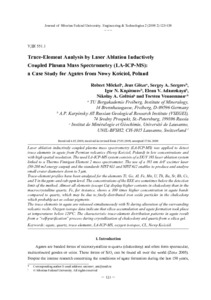Trace-Element Analysis by Laser Ablation Inductively Coupled Plasma Mass Spectrometry (LA-ICP-MS): a Case Study for Agates from Nowy Kościoł, Poland
Скачать файл:
URI (для ссылок/цитирований):
https://elib.sfu-kras.ru/handle/2311/1282Автор:
Mockel, Robert
Götze, Jens
Sergeev, Sergey A.
Kapitonov, Igor N.
Adamskaya, Elena V.
Goltsin, Nikolay A.
Vennemann, Torsten
Дата:
2009-06Аннотация:
Laser ablation inductively coupled plasma mass spectrometry (LA-ICP-MS) was applied to detect
trace elements in agate from Permian volcanics (Nowy Kościoł, Poland) in low concentrations and
with high spatial resolution. The used LA-ICP-MS system consists of a DUV 193 laser ablation system
linked to a Thermo Finnigan Element 2 mass spectrometer. The use of a 193 nm ArF excimer laser
(50-200 mJ energy output) and the standards NIST 611 and NIST 612 enables to produce and analyse
small crater diameters down to 5 μm.
Trace-element profiles have been analyzed for the elements Ti, Ge, Al, Fe, Mn, U, Th, Ba, Sr, Rb, Cs,
and Y in the ppm- and sub-ppm level. The concentrations of the REE are sometimes below the detection
limit of the method. Almost all elements (except Cu) display higher contents in chalcedony than in the
macrocrystalline quartz. Fe, for instance, shows a 100 times higher concentration in agate bands
compared to quartz, which may be due to finely distributed iron oxide particles in the chalcedony
which probably act as colour pigments.
The trace elements in agate are released simultaneously with Si during alteration of the surrounding
volcanic rocks. Oxygen isotope data indicate that silica accumulation and agate formation took place
at temperatures below 120°C. The characteristic trace-element distribution patterns in agate result
from a self-purification process during crystallization of chalcedony and quartz from a silica gel.

